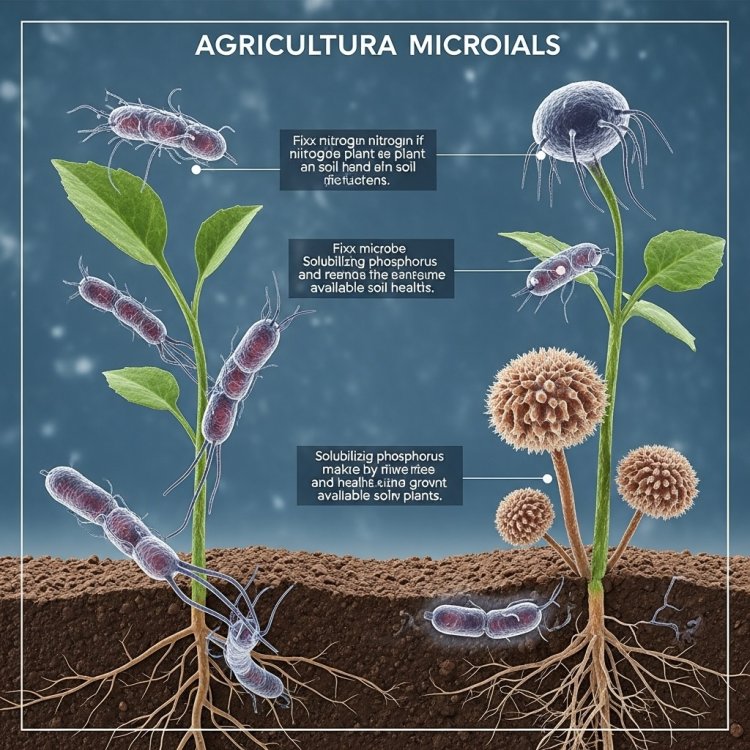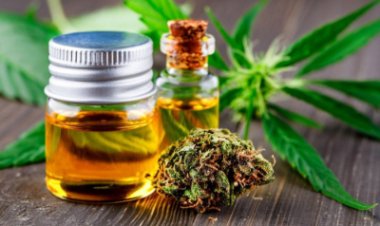Agricultural Microbials Market: Trends, Growth, and Future Insights (2025-2035)
Explore the booming agricultural microbials market, key trends, drivers, regional insights, and competitive landscape. Learn how microbials are shaping sustainable agriculture worldwide.

Key Takeaways
- The global agricultural microbials market is valued at USD 7.32 billion in 2024 and is projected to reach USD 33.21 billion by 2035, growing at a CAGR of 14.90%.
- Key drivers include the rise of organic farming, sustainable agriculture practices, and innovations in microbial formulations.
- North America leads the market, while Asia Pacific and Latin America are emerging as high-growth regions.
- Major challenges include product shelf life, storage, and regulatory hurdles.
- Leading companies are focusing on R&D, collaborations, and mergers to strengthen their market position.
Market Overview of Agricultural Microbials
The Agricultural Microbials Market is experiencing a remarkable transformation, driven by the global shift towards sustainable and eco-friendly farming practices. Agricultural microbials—comprising beneficial bacteria, fungi, and viruses—are increasingly being adopted as alternatives to traditional chemical fertilizers and pesticides. These microorganisms play a crucial role in enhancing plant growth, improving soil fertility, and protecting crops from pests and diseases, making them indispensable in modern agriculture.
According to Vantage Market Research, the global agricultural microbials market is valued at USD 7.32 billion in 2024. The market is expected to witness exponential growth, reaching an estimated USD 33.21 billion by 2035, at a robust CAGR of 14.90% between 2025 and 2035. This impressive growth trajectory is fueled by several factors, including the rising demand for organic food, increasing awareness about the environmental impact of chemical inputs, and the need for sustainable agricultural solutions.
Key factors driving market expansion include the growing prevalence of soil degradation and the urgent need to restore soil health. Microbials offer a natural way to replenish soil nutrients and promote plant resilience, which is particularly important in regions facing the adverse effects of intensive farming. Additionally, the global push for reducing greenhouse gas emissions and minimizing chemical runoff into water bodies has further accelerated the adoption of microbial-based products.
Regionally, North America currently dominates the agricultural microbials market, owing to its advanced agricultural infrastructure, high adoption rates of innovative technologies, and supportive regulatory frameworks. Europe follows closely, with a strong emphasis on organic farming and stringent environmental regulations. Meanwhile, Asia Pacific and Latin America are emerging as high-potential markets, driven by expanding agricultural activities, increasing government support, and a growing population demanding safer food products.
To understand more about Agricultural Microbials Market- Click for Download a Sample Report in minutes!
The agricultural microbials market is poised for significant growth, underpinned by the global movement towards sustainable agriculture, technological advancements, and favorable policy environments. As farmers and agribusinesses continue to seek effective and environmentally responsible solutions, agricultural microbials are set to play a pivotal role in shaping the future of food production.
Key Trends in Agricultural Microbials Market
The agricultural microbials market is characterized by several key trends that are shaping its evolution and driving its rapid expansion. One of the most prominent trends is the rise of organic farming and shifting consumer preferences towards organic and residue-free food products. As consumers become more health-conscious and environmentally aware, the demand for organically grown produce has surged, prompting farmers to adopt microbial-based solutions that align with organic certification standards.
Another significant trend is the widespread adoption of sustainable agricultural practices. Governments, NGOs, and industry stakeholders are increasingly advocating for farming methods that minimize environmental impact and promote long-term soil health. Agricultural microbials, with their ability to enhance nutrient cycling, suppress soil-borne pathogens, and improve plant vigor, are at the forefront of this movement. Their use not only reduces reliance on synthetic chemicals but also supports biodiversity and ecosystem resilience.
Innovation in microbial product formulations is also a key trend driving market growth. Advances in biotechnology and microbial genomics have enabled the development of highly effective and targeted microbial products. Companies are investing heavily in research and development to create next-generation biofertilizers, biopesticides, and biostimulants that offer improved efficacy, stability, and ease of application. Encapsulation technologies, for example, are being used to enhance the shelf life and performance of microbial products, addressing one of the major challenges in the market.
Furthermore, the integration of digital agriculture and precision farming technologies is amplifying the impact of agricultural microbials. Farmers are leveraging data analytics, remote sensing, and soil health monitoring tools to optimize the application of microbials, ensuring maximum benefits and cost-effectiveness. This trend is particularly evident in developed markets, where technology adoption is high and farmers are keen to maximize yields while minimizing environmental footprints. the agricultural microbials market is being shaped by a confluence of trends, including the rise of organic farming, the push for sustainability, and ongoing innovations in product development. These trends are not only expanding the market but also redefining the way agriculture is practiced, paving the way for a more sustainable and resilient food system.
Market Dynamics: Drivers and Restraints
The agricultural microbials market is propelled by a range of dynamic factors that both drive and restrain its growth. On the positive side, the benefits of agricultural microbials in promoting sustainability are a major driver. Microbials offer a natural and effective means of enhancing crop productivity, improving soil health, and reducing the environmental impact of agriculture. By facilitating nutrient uptake, suppressing harmful pathogens, and promoting plant growth, microbials help farmers achieve higher yields with fewer chemical inputs, aligning with global sustainability goals.
Another key driver is the increasing support from governments and international organizations. Many countries are implementing policies and subsidies to encourage the adoption of bio-based agricultural inputs. These initiatives are aimed at reducing the use of synthetic fertilizers and pesticides, mitigating soil and water pollution, and promoting organic farming. For instance, the European Union’s Common Agricultural Policy (CAP) and the United States Department of Agriculture (USDA) offer various incentives for farmers who adopt sustainable practices, including the use of microbials.
However, the market also faces several restraints that could hinder its growth. One of the primary challenges is the shelf life and storage of microbial products. Unlike chemical inputs, microbials are living organisms that require specific conditions to remain viable and effective. Factors such as temperature, humidity, and exposure to sunlight can significantly impact their efficacy, posing logistical challenges for manufacturers, distributors, and end-users. Ensuring consistent product quality and performance across diverse climatic conditions remains a significant hurdle.
Regulatory challenges also pose a restraint to market growth. The registration and approval process for microbial products can be complex and time-consuming, varying significantly across regions. In some countries, the lack of clear regulatory guidelines for bio-based inputs creates uncertainty for manufacturers and slows down product commercialization. Additionally, the need for extensive field trials and data to demonstrate efficacy and safety adds to the time and cost of bringing new products to market.
Despite these challenges, the overall outlook for the agricultural microbials market remains highly positive. Ongoing research and technological advancements are addressing many of the existing limitations, while growing awareness and policy support continue to drive adoption. As the industry matures, it is expected that regulatory frameworks will become more streamlined, and innovations in formulation and delivery will overcome current barriers, unlocking the full potential of agricultural microbials.
Segment Analysis of Agricultural Microbials
The agricultural microbials market is segmented based on product type, application, and crop type, each playing a distinct role in shaping market dynamics. Among product types, biofertilizers and biopesticides are the leading segments, collectively accounting for a significant share of the market. Biofertilizers, which include nitrogen-fixing bacteria and phosphate-solubilizing microorganisms, are widely used to enhance soil fertility and promote plant growth. Biopesticides, on the other hand, leverage beneficial microbes to control pests and diseases, offering an eco-friendly alternative to chemical pesticides.
Within the application segment, soil treatment and seed treatment are the dominant categories. Soil treatment involves the application of microbials directly to the soil to improve its health and fertility, while seed treatment focuses on coating seeds with beneficial microbes to protect them from pathogens and enhance germination. Foliar application, where microbials are sprayed onto plant leaves, is also gaining traction, particularly for disease management and stress tolerance.
Crop type is another important segment driving demand for agricultural microbials. Cereals and grains, such as wheat, rice, and corn, represent the largest market share, given their global importance as staple foods. Fruits and vegetables are also significant contributors, as these high-value crops are particularly susceptible to pests and diseases and benefit greatly from microbial protection. Additionally, the cultivation of oilseeds and pulses is increasingly incorporating microbial solutions to boost yields and improve crop quality.
Market share analysis reveals that certain products and applications are more prevalent in specific regions, reflecting local agricultural practices and crop preferences. For example, biofertilizers are widely used in Asia Pacific, where rice and legume cultivation is prominent, while biopesticides have gained significant traction in North America and Europe, driven by stringent regulations on chemical pesticide use. the segment analysis of the agricultural microbials market highlights the diverse range of products, applications, and crop types that are driving market growth. As farmers seek tailored solutions to address specific challenges, the demand for specialized microbial products is expected to rise, further fueling market expansion.
Regional Market Insights
The agricultural microbials market exhibits distinct regional trends, with North America currently holding the largest market share. The region’s dominance is attributed to its advanced agricultural sector, high adoption rates of innovative technologies, and supportive regulatory environment. The United States, in particular, has been at the forefront of microbial product development and commercialization, driven by strong research infrastructure and a proactive approach to sustainable agriculture.
Europe is another key market, characterized by a strong emphasis on organic farming and environmental sustainability. The European Union’s stringent regulations on chemical inputs and its commitment to the European Green Deal have accelerated the adoption of microbial solutions. Countries such as Germany, France, and Spain are leading the way in integrating microbials into mainstream agricultural practices.
Asia Pacific is emerging as a high-growth region, fueled by expanding agricultural activities, a large and growing population, and increasing government support for sustainable farming. Countries like China and India are investing heavily in agricultural modernization, with a focus on improving soil health and crop productivity. The adoption of microbials is being driven by the need to address soil degradation, reduce input costs, and meet the rising demand for safe and healthy food.
Latin America, particularly Brazil and Argentina, is also witnessing rapid growth in the agricultural microbials market. The region’s vast agricultural land, coupled with a strong focus on export-oriented crop production, has created significant opportunities for microbial product adoption. Government initiatives to promote sustainable agriculture and reduce chemical usage are further supporting market growth.
The regulatory landscape plays a crucial role in shaping regional market dynamics. While North America and Europe have well-established regulatory frameworks for microbial products, other regions are still developing clear guidelines. Harmonization of regulations and increased investment in research and development are expected to facilitate market expansion in emerging regions.
In regional market insights reveal a dynamic and evolving landscape, with North America and Europe leading the way, and Asia Pacific and Latin America poised for significant growth. The interplay of local agricultural practices, regulatory environments, and market demand will continue to shape the future of the agricultural microbials market.
Competitive Landscape in Agricultural Microbials
The competitive landscape of the agricultural microbials market is characterized by intense rivalry among major players, a strong focus on innovation, and a wave of strategic collaborations and mergers. Leading companies such as Bayer CropScience, BASF SE, Syngenta AG, Corteva Agriscience, and Novozymes are at the forefront of the market, leveraging their extensive research capabilities and global reach to develop and commercialize advanced microbial products.
Market leaders are adopting a variety of strategies to strengthen their positions, including investments in research and development, expansion into new markets, and the introduction of novel product formulations. Innovation is a key differentiator, with companies focusing on developing microbial consortia, next-generation biofertilizers, and biopesticides that offer enhanced efficacy and stability. The use of advanced delivery systems, such as encapsulation and controlled-release technologies, is also gaining traction, addressing challenges related to shelf life and application.
Collaborations and mergers are playing a significant role in shaping the industry. Companies are partnering with research institutions, universities, and startups to accelerate product development and gain access to cutting-edge technologies. Mergers and acquisitions are enabling market players to expand their product portfolios, enter new geographic markets, and achieve economies of scale. Recent examples include Bayer’s acquisition of biologicals company AgraQuest and BASF’s partnership with biologicals startup AgBiome.
The focus on sustainability and environmental stewardship is also influencing competitive strategies. Companies are increasingly aligning their product development efforts with global sustainability goals, emphasizing the role of microbials in reducing chemical inputs, improving soil health, and supporting regenerative agriculture. the competitive landscape of the agricultural microbials market is dynamic and rapidly evolving, driven by innovation, strategic partnerships, and a shared commitment to sustainable agriculture. As the market continues to grow, competition is expected to intensify, with companies vying to deliver the most effective and environmentally friendly solutions to farmers worldwide.
FAQs
- What are agricultural microbials and how do they benefit farming?
- What is the current market value of agricultural microbials and what are the growth projections?
- How do agricultural microbials contribute to sustainable farming practices?
- What role do agricultural microbials play in pest and disease management?
Conclusion
Agricultural microbials are revolutionizing the way we grow food, offering sustainable, effective, and environmentally friendly solutions to some of agriculture’s most pressing challenges. With robust market growth, ongoing innovation, and increasing global adoption, microbials are set to play a central role in the future of farming. As the industry continues to evolve, staying informed about market trends, regional dynamics, and competitive strategies will be essential for stakeholders looking to capitalize on the opportunities presented by this exciting sector.


















